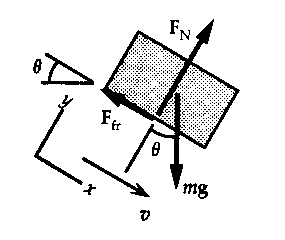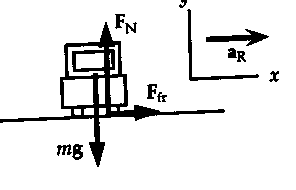PHYSICS 100A SELF TEST (1)
1.A hunter aims directly at a target (on the same level) 120m away. (a) If the bullet leaves the gun at a speed of 250m/s, by how much will it miss the target? (b) At what angle should the gun be aimed so the target will be hit?
Solution. (a) We choose a coordinates system with the origin at
the release point, with x horizontal and y vertical with the
positive direction down. We find the time of flight from the horizontal motion.
x = x0 + v0t;
120m = 0 + (250m/s)t, which gives t = 0.480s.
We find the distance the bullet falls from
y = y0+ v0yt + 1/2at2;
y = 0 + 0 + 1/2(9.80m/s2)(0.480s)2 = 1.13m.
(b) The bullet will
hit the target at the same elevation, so we can use the expression for the
horizontal range:
R = v02sin(2q0)/g;
120m = (250m/s)sin(2q0)/(9.80m/s2),
which gives sin(2q0) = 0.0188, or 2q0 =
1.08°, or q0 =
0.54°.
The larger angle of 89.5° is not realistic.
2. A 2.5 N force is uniformly applied to a 1.5kg- cart at rest.
(a) After 10 seconds how far away the car is traveling? (b) At that time
the 2.5-N force is removed. What force is
needed to stop the cart in 10m?
Solution. (a) We find the acceleration of the cart from
F = ma
25N = (1.5kg)a, which gives a = 1.67m/s2.
We find the distance the car travels in 10s from
x = x0 + v0t + 1/2at2;
x = 0 + 0 + 1/2(1.67m/s2)(10s)2 = 83.33m.
(b) We find the velocity of the car at t = 10s from
v = v0 + at = 0 + (1.67m/s)(10s) = 16.7m/s.
We find the acceleration of the cart when the cart is decelerating from
v2
= v02 + 2a(x - x0)
0 = (16.7m/s)2 + 2a(10m - 0); which gives a =
-13.94m/s2.
We find the force from
F = ma = (1.5kg)(-13.94m/s2) = -20.92N.
The force is in the opposite direction.
3. An 18.0-kg box is released on a 37.0 incline and accelerates down the incline at 0.270m/s. Find the friction force impeding its
motion. How large is the coefficient of friction?
| Solution While the box is sliding down, friction will be up
the place, opposing the motion. From the force diagram for the box, we
have SF = ma:
x-component: mgsin q - Ffr
= ma;
y-component: F - mgcos q =
0.
From
the x-equation, we have
Ffr = mgsin q - ma = m(gsin q
- a)
= (18.0kg)[(9.80m/s2)sin37.0° - (0.270m/s2)]
= 101N.
Because
the friction is kinetic, we have
Ffr = mkFN = mkmgcos q;
101.3N = mk
= 0.719.
|
 |
4. A
car is to make a turn around a level curve of radius 80m at a speed of 60km/h.
What is the minimum value of coefficient of friction between the tires and the
road that the car will not skid?
| Solution. The friction force provides the centripetal
acceleration. We take a coordinate system with the x-axis in the
direction f the centripetal acceleration.
We write SF = ma from
the force diagram for the car:
x-component: Ffr = ma = mv2/r;
y-component: FN - mg = 0.
If the car does not skid, the friction is static, with Ffr
< msF.
Thus we have
mv2/r < msmg, or
ms > v2/gr
= [(60km/h)(1000m/km)/(3600s/h)]2/(9.80m/s2)(80m)
= 0.35.
Thus ms > 0.35.
|
 |

